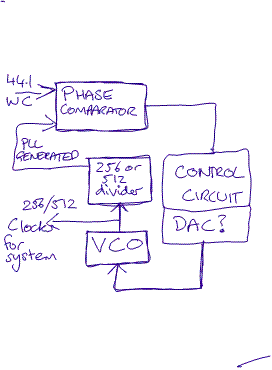Mohammed vs the mountain: you mention ADAT to AD/DA. The best possible jitter performance can be achieved by making the AD/DA the clock master, and ensuring that the AD/DA clock has low jitter (by using clocks like the Kwak clock or the Tent XO). All other factors being equal, oscillator jitter performance is determined by the Q of its resonant circuit (higher Q = less jitter), and a voltage controlled oscillator (required when the AD/DA has to lock to ADAT) will by definition need to have a lower Q than a fixed-frequency oscillator. So if you can get away with it, lock ADAT to AD/DA and not the other way around (prevention vs cure and all that). With a little care you can get <10ps jitter (and with lots of care, a PhD in RF design and a solid dose of OCD you might get <1ps).
If this isn't possible for technical or political reasons, Rochey is right that an Asynchronous Sample Rate Converter (ASRC) is a good way to go. Don't get too hung up on the sample-rate conversion; ASRCs are being used for jitter rejection in lots of high-end equipment nowadays. Think about it: to convert from rate x to rate y, an ASRC needs to know the ratio x/y between its input and output clocks. Very roughly speaking, it uses a digital PLL to lock to the incoming signal. Because the bandwidth of this PLL is relatively narrow, its jitter rejection performance can be very good. For more info, see page 34 and onward of
the TI SRC4392 datasheet (particularly figure 73 showing the jitter filter performance), or
AN270 from Cirrus Logic, showing how SRCs can help you keep separate clock domains. The downside is that, due to DPLL noise and the like, a very small bit of the phase noise will get 'mixed into' the post-SRC signal (but still less than what you'd see when the ADAT were to directly clock a DAC).
If you must use an external sync, word clock over BNC can have better jitter performance than a regenerated ADAT clock. However, I know of no existing ASRC that will lock to a word clock (as opposed to bit clock), so you'll need to roll your own PLL.
Me, I'm planning to use a mix of an ASRC (likely the SRC4392 if I can manage the 0.5mm pin pitch, or else the CS8421) and a hand-rolled PLL. For the PLL I think I'll use a low noise high frequency crystal clock driving an Analog Devices Direct Digital Synthesis (DDS) chip, with an AVR microcontroller providing the frequency/phase detection and correction. A free-running crystal oscillator will drift less than a PPM per minute, which is easily tracked with the DDS. If and when I ever get this working, I'll post a comparison of jitter rejection between the ASRC and the DDS PLL.
Plenty to do,
JDB.
[EDIT: Yet Another Typo]

